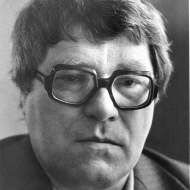The start of Miloslav Istvan\'s career as a composer falls into the time of his studies at Janacek Academy of Music and Dramatic Arts (1948-1952, research student 1953-1956). In Brno, he came to an appreciation of Janacek\'s creative heritage, and at the same time the attention of the youth was turned toward the rich sources of folk music, a tradition kept alive in Moravia.
From Janacek\'s uncompromising innovation there was only one stop for Istvan to Bartok\'s modal composition. The study of Moravian folklore took him later on to Balkan, Asian and African folklores. Anything that brought about new views of musical structure, new harmonic and sonic solutions avoiding contemporary schematization, Istvan absorbed with the eagerness of youth, but also with a critical distance and an expanding opinion of his own.
At the turn of the fifties and the sixties when he was active at JAMU as a teacher of composition (since 1957 senior assistant, since 1976 reader), he concluded his years of seeking with a symphonic fresco entitled Ballad on the South, which, in spite of the after-effects of Bartok and Shostakovich, bears individual features of his own: robust dramatic expression and non-sentimental, socially committed feeling. In a stage of realization of basic ways out, Istvan was influenced by information on the development of the 2nd Viennese School and its after 1945 development as the aesthetic of post-Webernian serialism. The composer adopted the twelve-tone technique. His creation, however, was overwhelmed by modal series connected with the typical intervals characteristic of the Moravian folk song. It was only in 1967 that he grasped a text that in the orchestral Exorcism of the Time he left in its natural spoken form, and only a year later, in the chamber Old Testament cantata I, Jacob, he put Hebrew extracts of the Bible to music, but the text important for its meaning was left with the reciter. In these works, where philosophical meditation about the sense of human existence is filled with the tension of dramatic clashes, Istvan reached his own way of cutting assembly, which in the future would remain a decisive technical mark of his musical communication and a basis for his poly-stylish solutions for composition. Istvan\'s assembly, applied both in music and in text, is based on the alteration of contrastive objects which in repeating are left essentially without change, only in various ways combined, permeated, thickened, or diluted. Even archaic signs of Renaissance and baroque music are presented in contrastive relation, as well as characteristic elements of contemporary beat and rock, which at the same time perform the function of a semantic symbol. From the point of the tectonic process of composition, but also with respect to the listener\'s reception, an important element of Istvan\'s compositions is the refrain, not a refrain in the traditional meaning, but as a short expressive model appearing repeatedly in crucial points and making the listener\'s orientation easier. The rhythms that entered to the foreground of the composer\'s interest in the seventies by means of Afro-Asian folklore enhanced the significance of the percussion, utilizing it in greater measure not only in the orchestra but also in chamber compositions (Psalmus niger, Capriccio, Duo for double bass and percussion, Trio for clarinet, percussion and piano). Inventive instrumental combinations, employing historical and popular instruments as well as sources of non-musical emblems, underline the timbre component, which has always been substantial in the strict formal structure of Istvan\'s work.
The eighties witnessed a number of mature compositions which were increasingly responsive to the instigations of the actual world. The thematic complexities of his works were concentrated on a passionate defense of the right to the dignity of man in such works as the chamber cantata Hard blues - a protest song with American Negro\'s lyrics, Love, Defiance and Death - a composition inspired by a realistic drama from Moravian life, and the indignantly brutal Tempus irae, remotely inspired by Steinbeck\'s novel The Grapes of Wrath. Several works were based on meditations about the content of human life, including the cantatas of the late sixties joined by the seven-part cycle Games, the lyrically conceived and compositionally simplified Vocal Symphony, and the subjective testimony in the String Quartet No. 2. Istvan emerged as a fully-fledged personality of contemporary Czech music, always bringing new inspirations to his work and winning the respect and admiration of both domestic and foreign listeners.

